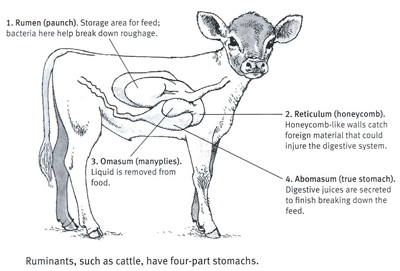Caught a picture of our little bull calf. His muzzle was dripping with milk but he slipped around mom, up to the hay feeder where all the cows were munching away. He nuzzled up to the feeder and took a bite to check out what everyone was up to.
At this age, he is beginning to practice eating forage. He still does not get much nutrition from it, but his gut is being colonized by the bacteria he will need on board, to help digest the cellulose (tough fibers). That’s what makes ruminates (cows, goats, sheep, etc) such useful creature. They can take forage on land unusable for crops, and convert it to food.
At birth, the four parts of the cow’s stomach are not “active”. Milk is shunted to the last stomach; the only one that can absorb nutrition from the milk. A calf lifts its head up to nurse, which shuts off the entrance to the other sections of the stomach. Calves that are fed from a bucket, with their heads down, do NOT shut off that entrance and tend to be very sickly; despite getting milk. They are NOT getting the food into their system.
Commercial cattlemen finally figured out they needed to raise the bucket up and the calves would be much healthier. Such a small observation of how mother nature works, made a huge difference in the health of calves off their moms.
As small amounts of milk & microbes, from the practice chewing/eating gets into the rumen, it becomes colonized with the different microbes that will handle different types of forage. A different group of microbes for grass, for alfalfa, for orchard grass, or teff, or blends. Once all the areas are colonized, the four compartments have very specialized functions. After eight weeks the calf’s rumen should be fully functioning. The rumen, his bulk storage container where food is first inoculated with microbes to break it down, will grow 25 times larger from birth to adulthood.
One of the things we do is transition any feed changes slowly, over a week or two, to give the microbes a chance to catch up! Otherwise we end up with cows with very “liquid” deposits!
Food/Forage management by poop analysis, would be a “polite” way to put it.

nicheca said,
June 17, 2019 at 3:33 pm
Hi there, is it possible to know the source of the graph that you used in this post? ‘Calf stomach compartments’
Many thanks in advance,
Nicheca
Farmer's Wife said,
June 24, 2019 at 5:11 pm
sorry, it’s been seven years…